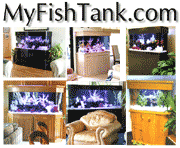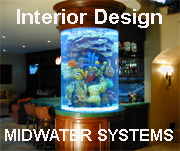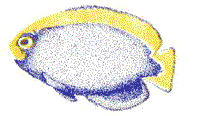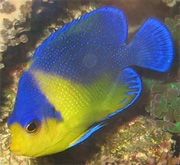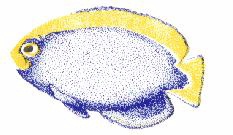|
Algae, The Good and the Bad
By Jim Stime and Jim Wolf
Of all the things that an aquarist generally dislikes algae is probably
at the top of the list. It covers the decorations, the rocks, the gravel,
it even spreads over the viewing panels into the aquarium. A large part
of the maintenance of an aquarium is cleaning off the algae growth.
Even though many algae's are disliked, there are some algae's that are
preferred, or needed. Lets identify the basics; Micro ( meaning small )
and Macro ( meaning large ) algae.
Micro algae's range from diatoms ( the brown dots on the glass ), filamentous
( hair algae ) and smear or slime ( actually not an algae but cyano-bacteria
) algae. These types of algae, although sometimes beneficial, in general
become problematic in our closed-system aquaria.
Macro algae's, referred to as seaweeds, are the various Caulerpas, Halimeda,
and Kelps. These forms of algae can be an attractive addition to the reef
tank, and provide a valuable food source to many of its fishes.
Where do algae's they come from, why are they growing in my tank, and
how do I control them or get rid of them ?
A new aquarium is essentially sterile. Not only is there very little
life in the aquarium, but the chemical environment is very hostile (high
pH, few organics, very oxidative). Quickly the aquarium starts to age as
species of bacteria and algae start to colonize the surfaces of the aquarium.
This process of the aquarium aging and the types of inhabitants changing
is called succession.
To successfully grow many of the desirable species of marco-algae, it
is crucial to let the aquarium age (a process called succession) to a point
where it can support the preferred species of algae. Typically a tank will
start to grow algae in about 2-6 weeks, after the nitrate cycle has been
completed.
The first forms are usually brown diatoms that appear as a coating on
all of the surfaces of the aquarium. Overtime these will fade away, and
start to give rise to patches of other green and red algae. This process
can be accelerated by providing strong lighting and good flow to the aquarium.
Should one have continual growths of this brown, or dot algae check your
freshwater supply or salt mix for elevated levels of silicates. Diatoms
utilize silica in their growth and structure. At the time in which other
non-brown algae start to form you can start to think about introducing
desirable types of algae ( ei: calerpa's and halimeda's ).
The concept of introducing caulerpa into an aquarium is that these algae's
will compete for the same nutrients as the micro algae. The 'algae scrubber'
method of filtration is based largely on the larger species of algae's,
sometimes referred to as 'turf' algae, utilizing the nutrients produced
within and aquarium as their food source. Interestingly, the largest number
of organisms on a coral reef are the turf algae's. It is these algae's that
actually help 'filter' the water, but are a significant portion of the
food source of a coral reefs inhabitants.
But before we go any further, a note on what has happened in you tank
up to this point is in order. The succession of algae from brown to other
types underlies a very critical point about culturing algae. That is that
algae literally, if left alone, will make life unbearable for themselves!
Over time a certain type of algae will use all of the available nutrients
that it needs specifically. It will the "crash", or literally die out.
In its place will be another type of algae that does not require the specific
types of nutrients that the other algae has used up. Once you have established
the growth of the algae that you are interested in, you have to periodically
prune it back, change the water, and add nutrients to insure that these
cultures will not crash as well.
Macroalgaes such as Caulerpa and Halimeda are the preferred algae for
many aquariums. These algae are quick growing and help to maintain good
water quality. Additionally, many fishes prefer these types of algae's
as a food source. Numerous authors promote these types of algae's as foods
suggesting that this can prevent, decrease, or eliminate HLLE ( head and
lateral line erosion ). As these algae's grow they can easily overcome
many corals. Occasional pruning of these types of algae's will help to keep
them in control. These 'pruned' algae's can either be dried out and used
as a food source, or bagged up and traded in at the local fish shop.
Occasionally an aquarium will become overgrown with undesirable filamentous
or film forming algae. These algae prefer areas of low flow and tend to
sprout in areas that debris's have settled into. To help retard their growth
it is crucial to have adequate water flow !
Here are a few hints to control unwanted hair algae growth.
Hair algae can easily overgrow other specimens in the aquarium (such
as corals). One way to control their population is by using herbivores
(plant eating species of animals). Small tangs, and many species of sea
urchins are excellent ways to control their growth. Astrea snails and Blue
Leg Hermit crabs can be a great help. Keep in mind that undesirable
algae's also taste undesirable, so don't expect everything you put into
the tank to graze on these algae's.
Another non-biological way to control hair algae growth is to control
the levels of nutrients available. Nitrate (NO3) and phosphates (PO4) should
be kept at undetectable levels at all times in tanks where macro algae
are preferred. Once the phosphate levels creep above 1 ppm, hair algae
may start to dominate. Minimize feeding, and if necessary use a zeolite
resin to remove excess phosphate (these are commercially available as phosphate
removers).
Protein skimmers can also be of some help. Skimmers help remove organic
compounds from the water.
Water changes can help dilute whatever nutrient is feeding the algae.
On the other hand, sometimes the nutrients are introduced via the new saltwater.
Some salt mixes contain higher levels of certain elements that encourage
these algae's. It could even be something in the freshwater that you are
using to make your saltwater.
( I once eliminated a hair algae problem by stopping the water changes
I was doing and within 30 days the problem was gone...completely ! )
Some authors promote " Prevention is the best cure ", well in a perfect
( aquatic ) world that may be true, but even in perfect systems algae can
grow. Keep in mind that a number of these undesirable algae's feed on extremely
low levels of nutrients, and to attain those levels can be quite difficult.
The truth is algae problems are not always resolved easily. Sometime
very radical means are required such as removal of the rock or sand. One
may even consider breaking down the entire aquarium and starting over.
Keep in mind that these are radical solutions.
|
